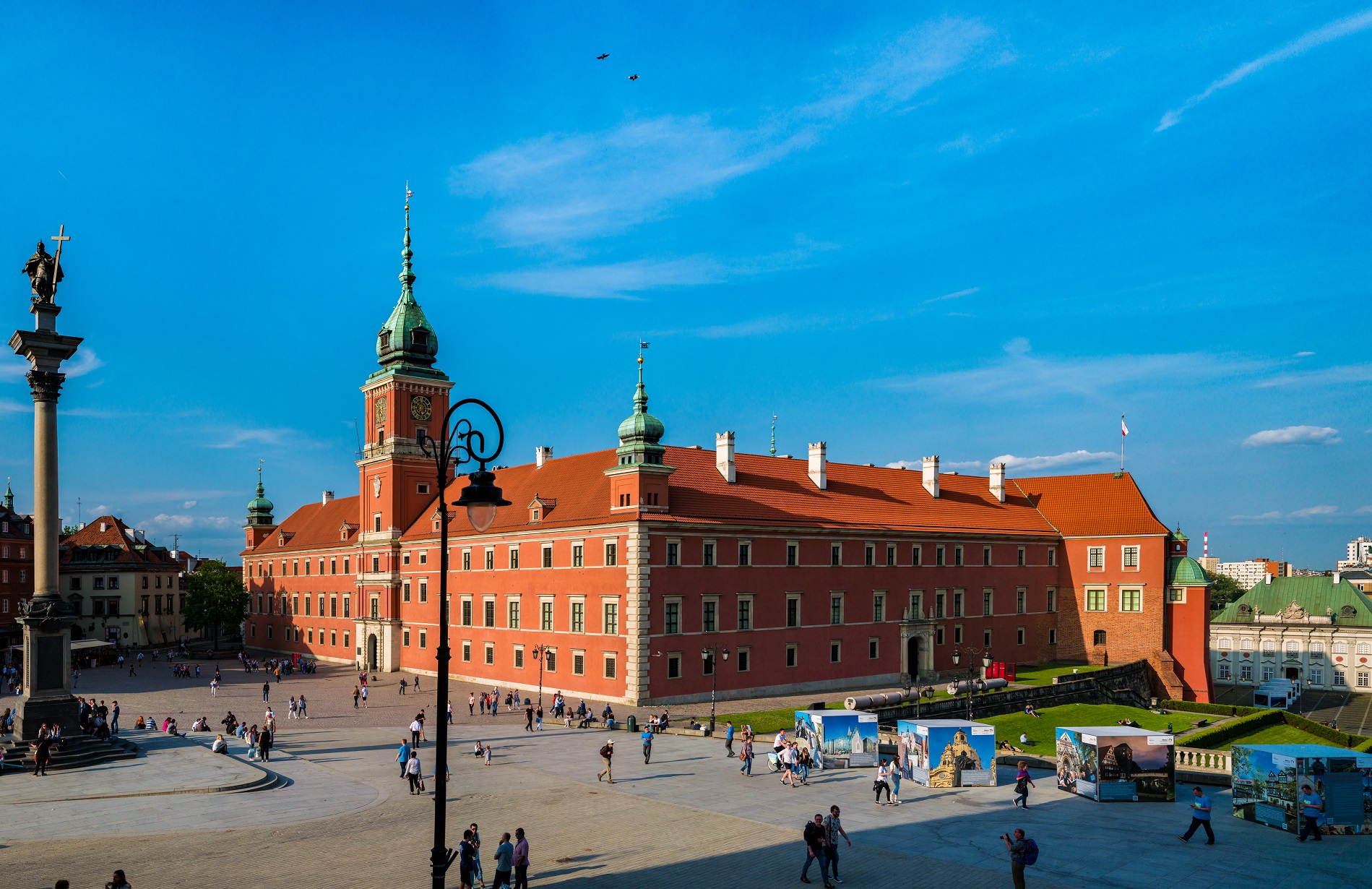Poland was one of the first countries to sign the UNESCO Convention for the Protection of the World Cultural and Natural Heritage. The sites and places included in this prestigious list represent the common heritage of mankind and are of exceptional value. Poland boasts no fewer than 17 sites on the UNESCO World Heritage List.
Warsaw’s Old Town: the most picturesque part of the capital
The Old Town of Warsaw was built on a medieval layout and surrounded by defensive walls from the 14th to 16th centuries. After the destruction of the Second World War, the area was rebuilt, becoming the only example in the world of a planned reconstruction on this scale. In 1994 it was declared a Historic-Artistic Site.
The symbol of the Old Town is the Castle Square with the Sigismund III Vasa Column (1644) and the Royal Castle, which was the seat of kings and now serves as a museum. Near the square is the Pod Blachą Palace (Copper-Roof Palace), rebuilt after war damage.
Świętojańska Street leads to the Old Town Square, where you can admire carefully reconstructed tenement houses and the Cathedral of St John the Baptist, associated with many important historical events, destroyed during the Warsaw Uprising and rebuilt in the Gothic style.
Krakow’s Old Town: the heart of Polish culture, with Wawel Castle, Sukiennice (the Cloth Hall) and Kazimierz
Experience Kraków with all your senses. The historic capital of Poland, full of legends, extraordinary stories, priceless monuments, magnificent works of art and unusual flavours, can charm and win the heart of any tourist at first sight.
The Old Town of Krakow is the oldest part of the city, full of history and beauty. Passing through Planty Park, Barbican and Florian Gate, we enter an extraordinary world that was saved after the Second World War. In the heart of the city is the Main Market Square, full of flower sellers, cab horses, and pigeons. Here you will also find St Mary’s Basilica and Sukiennice (the Cloth Hall), where amber, silver and handicrafts have been traded for centuries.
On the first floor of Sukiennice there is a gallery of 19th century Polish art with works by artists such as Henryk Siemiradzki, Władysław Podkowiński, Jan Matejko and Józef Chełmoński. The Czartoryski Museum is also worth a visit – it houses paintings by Leonardo da Vinci and Rembrandt.
Muskau Park: an example of a beautiful park
Muskau Park is one of the most beautiful and largest English-style parks in Poland and Germany, stretching along both sides of the Neisse River. The park was founded by Prince Hermann von Pückler-Muskau, who between 1815 and 1844 created a garden inspired by English landscape parks. Set in a picturesque landscape, the 700-hectare park combines nature, culture and technology. Highlights include the New Palace and numerous bridges, including the Viaduct and the Prince’s Bridge. Most of the park is on the Polish side (Łęknica municipality), where it is managed by the National Institute of Heritage.
The Wieliczka and Bochnia Royal Salt Mines: underground cities of salt sculptures and chapels
They are among the oldest rock salt mines in the world and the longest operating industrial facilities. The Wieliczka Salt Mine is a unique facility with nine levels. The tourist route in the mine leads through 20 chambers at depths of 64 to 135 metres. Attractions include the Chapel of St Kinga, the largest underground church, the Pieskowa Skała Chamber and the Underground Rehabilitation and Treatment Centre. The mine also has a museum and a concert hall. The Salt Mine Castle in Wieliczka, the former headquarters of the mine management, is a UNESCO World Heritage Site. The castle consists of three main buildings and offers archaeological exhibitions and guided tours. The Bochnia Salt Mine, the oldest in Poland, was founded in 1248. It features underground tours around unique chambers and chapels as well as a multimedia exhibition.
Auschwitz-Birkenau: Despite its painful history, this site is extremely important for remembering the past.
Auschwitz-Birkenau, a German Nazi concentration and extermination camp (1940-1945), is a symbol of planned genocide and the Shoah. It was established by the Germans in mid-1940 on the grounds of the military barracks in Oświęcim. Today it is a monument to the dark pages of history in a living city. In 1947, the Auschwitz-Birkenau State Museum was established on the site of the two remaining parts of the camp: Auschwitz I and Auschwitz II-Birkenau. Today, Auschwitz-Birkenau is a place of remembrance and education that attracts visitors from all over the world. As a museum and a memorial to the victims, it bears witness to the atrocities of the Second World War and serves as a reminder of the need to combat hatred, intolerance and all forms of discrimination.
Białowieża Forest: the last primeval forest in Europe, with bison and other wild animals
The heart of this ancient forest is over 500 years old. The Białowieża National Park lies within its borders. The symbol of the forest and the park is the European bison, the largest free-roaming population in the world (over 800 individuals). The national park is home to unique oak, lime and hornbeam forests, as well as lowland pine forests. Oak, hornbeam, maple, pine and spruce dominate. Wolves, lynx and other species live in the forest along with bison. The forest has been preserved in an almost pristine state, making it a unique place with a high level of biodiversity.
The Old Town of Zamość: a pearl of Renaissance town planning
Built on the model of the Italian city of Padua, Zamość was founded by Jan Zamoyski, a chancellor who was in love with Italy. The city, surrounded by fortified walls, survived numerous attacks, including those by Khmelnytsky and during the Swedish Deluge. Today, Zamość is a Renaissance jewel, with one of the largest fortresses of the First Polish Republic. Every year the show of the Zamość Fortress Assault takes place, with the participation of knightly brotherhoods and military, fencing and archery demonstrations.
Zamość has many tourist attractions, including the Market Square with guides dressed in period costume, the Underground Route of the Town Hall Outbuildings, the Synagogue, and the Zamość Museum. The oldest functioning pharmacy in Poland is also located on the market square, and the town hosts many festivals and cultural events. Jan Zamoyski, the city’s founder, is buried in the cathedral and his statue stands in front of the Zamoyski Palace. The city also offers concerts, fountains and a modern zoo.
Wooden churches of southern Małopolska: unique monuments of wooden architecture
The wooden churches of southern Małopolska (Lesser Poland) – Binarowa, Blizne, Dębno, Haczów, Lipnica Murowana and Sękowa – are monuments of great historical and architectural value. They represent the Gothic, Renaissance and Baroque styles. Most of them were built of timber, the oldest being the church in Haczów from 1388. These churches are located on the Wooden Architecture Tourist Route, which runs through Małopolska, Podkarpacie (Subcarpathia) and Śląsk (Silesia).
Kalwaria Zebrzydowska: a sanctuary of the Virgin Mary with an exceptional architectural and landscape complex and a pilgrimage park dating from the 17th century.
Located on the Papal Route, it is a famous pilgrimage destination featuring a Bernardine sanctuary. It is characterised by churches, shrines and statues, the most valuable of which is the painting of Our Lady of Calvary in the Zebrzydowski Chapel. The town is famous for its re-enactment of Golgotha during Holy Week and the Passion Play during the August Fair. Founded in 1600 by Mikołaj Zebrzydowski, Kalwaria uses the natural landscape as a backdrop for the Passion of Christ, creating a unique cultural landscape combining nature and baroque architecture.
The Castle of the Teutonic Order in Malbork: a Gothic fortress
The largest surviving fortress in medieval Europe, Malbork Castle consists of the Lower, Middle and Upper Castles. Construction began in the 13th century and took 30 years. The red brick castle, surrounded by defensive walls, has an impressive volume of 250,000 cubic metres. The best view of the castle is from the Nogat River. Inside, there is a courtyard with cloisters, a fountain with a pelican and architectural details, including realistic scenes of medieval life. The castle was the seat and capital of the Order of the Teutonic Knights, and was later extended with a refectory and the Grand Master’s palace. The castle museum has exhibitions of weapons, amber, porcelain and handicrafts. The siege of Malbork is re-enacted every year.
The Medieval City of Toruń: the oldest part of Toruń, consisting of the Old Town, the New Town and the Teutonic Castle.
Toruń, one of the oldest cities in Poland, has its roots in the 13th century, when the Teutonic Knights demarcated the oldest part of the city, commonly referred to as an island, and built a castle. The city, a member of the Hanseatic League, developed rapidly thanks to trade. The first tenement houses were built in the Middle Ages, and until the 15th century the town was dominated by brick buildings. The Old Town of Toruń includes the Town Hall, city walls, towers, tenement houses, palaces, churches, and manor houses. The panoramic view of the city from the Vistula River is well worth seeing. Toruń is also the hometown of the famous astronomer Nicolaus Copernicus. In a tenement house on a street named after him, there is a museum dedicated to his life and scientific work. Toruń is also famous for its gingerbread.
The historic buildings of Toruń, built from the 13th century in the North German Gothic style, have survived almost unchanged, with city walls, gates and defensive towers. The Old Town Hall, considered one of the most outstanding examples of civic architecture in Europe, now houses the District Museum. The complex also includes a 40-metre tower. In front of the Town Hall there is a Nicolaus Copernicus monument. Next to the monument, after 210 years of absence, a donkey has been erected – a former pillory, now an attraction for tourists (especially for the youngest ones).
Historic Silver Mine in Tarnowskie Góry
The lead, silver and zinc ore mine in Tarnowskie Góry, together with the underground water management system, is a complex of 28 sites added to the UNESCO World Heritage List in 2017. These sites, located mainly in Tarnowskie Góry and partly in Bytom and Zbrosławice, are associated with metal mining and a pioneering underground drainage and water supply system.
The underground workings include a network of galleries, chambers and shafts (in total, over 150 kilometres long), which is the only integrated drainage system in the world. Key facilities include the Friedrich Deep Shaft, the Pokój Shaft and the Bohr Shaft. Other important elements of the infrastructure include the Staszic Shaft, the waterworks and various ventilation and auxiliary shafts, such as the Anioł Shaft and the Reden Shaft, where the first steam engine in Europe was operated.
Shafts such as Boże Wspomóż and Fryderyk, as well as mining remains including dumps and a post-mining landscape bear witness to the region’s centuries-old mining history. The preserved buildings and landscapes are unique technical and industrial monuments.
Group of architecturally interesting timber churches in the Carpathians
On the Polish side of the Carpathians there are timber churches in Chotyńce, Radruża, Smolnik, Turzańsk, Brunary Wyżne, Kwiaton, Owczary, and Powroźnik.
The Orthodox Church of the Nativity of the Holy Virgin in Chotyńce (Podkarpackie), built around 1600, is one of the oldest wooden Greek-Catholic churches in Poland. Its polychrome decoration from the 18th century and a five-storey iconostasis from 1671 make it an important monument.
The Orthodox Church of St. Paraskeva in Radruża (Podkarpackie Province), built in 1583, is the oldest type of Halych church. The interior was decorated with polychrome paintings in the 17th century and the Orthodox church complex includes a cemetery, a bell tower and a morgue.
The Church of St Michael the Archangel in Smolnik (Podkarpackie), built in 1791, is a classic example of a Boyko church, restored in 1969. Elements of the 18th century polychrome decoration have been preserved and some of the furnishings are in museums.
The Orthodox Church of St Michael the Archangel in Turzańsk (Podkarpackie), built between 1801 and 1803, is a five-domed temple in the Eastern Lemko style, decorated with polychrome and icons from the 19th century. The church has a three-storey bell tower from 1817 and its interior is decorated with local motifs that are an integral part of the mountain landscape.
The Orthodox Church of St Michael the Archangel in Brunary Wyżne (Małopolskie), built in 1797, is an example of a Western Lemko Orthodox church. The interior contains polychromes from the 18th and 19th centuries, a baroque iconostasis and altars, as well as elements of the 18th century interior. The Orthodox Church of St Paraskevi in Kwiatoń (Małopolskie), dating from the 17th century, is a high Western Lemko Orthodox church, decorated with polychrome from the 18th and 19th centuries, an iconostasis by Michał Bogdański and a 19th century altar.
The Orthodox Church of the Protection of the Holy Virgin in Owczary (Małopolskie Voivodeship), built in 1653, is a West Lemko Orthodox church with polychrome and baroque decoration. It was awarded the Europa Nostra award for its excellent preservation. The 17th century Church of St James the Younger Apostle in Powroźnik (Małopolskie) is the oldest West Lemko Orthodox church with polychrome from 1637 and a baroque iconostasis. The church was moved in 1813 due to flooding, but its original structure was preserved.
The ancient and primeval beech forests of the Carpathians: a relatively undisturbed example of a temperate beech forest
After the Białowieża Forest, the Ancient and Primeval Beech Forests of the Carpathians are the second natural site in Poland to be included on the UNESCO World Heritage List. Within the Polish part of the site, called Bieszczady, four fragments of beech forests with a total area of approx. 8,600 acreshave been identified: The Border Range and the Upper Solinka Valley; The Wetlińska and Smerek Mountain Meadows – the valleys of the Tworylczyk and Hylaty Streams; The valley of the Terebowiec Stream, The valley of the Wołosatka Stream.
The beech forest fragments in the Bieszczady Mountains are located in the most inaccessible areas of the Bieszczady National Park, which have received the highest rating in terms of naturalness as a result of extensive natural valorisation.
Krzemionki: The Krzemionki Area of Prehistoric Flint Mining
The flint mines in Krzemionki near Ostrowiec Świętokrzyski are a unique monument from the Neolithic and Early Bronze Age (c. 3900-1600 BC) and are a recognised historical monument. Covering an area of 80 hectares, there are over 4,000 mines from which flint was extracted for the production of tools. Krzemionki is one of the best preserved sites of its kind in the world. The main tourist attraction is the 500-metre underground route, the only one of its kind open to the public. Archaeological workshops are held in the reconstructed Neolithic settlement, and a new exhibition displays archaeological and natural history exhibits.
Centennial Hall in Wroclaw: a unique building with the longest reinforced concrete roof span in the world.
The Centennial Hall in Wroclaw was designed in the Expressionist style by Max Berg between 1911 and 1913. Built of reinforced concrete, it was a technological breakthrough with a dome measuring 67 metres in diameter and 42 metres high. Inaugurated on 20 May 1913, it initially housed the largest organ in the world. It was built to commemorate the 100th anniversary of the Battle of the Nations near Leipzig and the Jubilee Exhibition on the site of a former racecourse. Max Berg won the design competition and his innovative solutions became a milestone in architecture.
The Churches of Peace in Jawor and Świdnica: famous for their unique architecture
The Churches of Peace in Jawor and Świdnica are impressive not only for their history and perfect half-timbered construction, but also for their beautiful polychrome interiors. They were built in the 17th century after the Peace of Westphalia, when Emperor Ferdinand III Habsburg allowed Silesian Lutherans to build them. The churches are modest on the outside, but impressive on the inside – the one in Jawor can hold 6,000 people, and the one in Świdnica even more – 7,500 including 3,000 seats. Both churches are in the hands of a few Protestant congregations. The Church of Peace in Świdnica is the largest wooden baroque church in Europe.
The article was created in cooperation with the Polish Tourist Organization.



Sledź nas na: